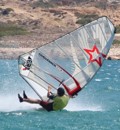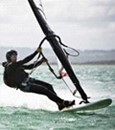by Tom Chalko >>
9-4-2010 13:50:52
>>
9-4-2010 13:50:52 | |
I would like to announce a 10s average speed Polish record attempt at Sandy Point, Australia on 11 and/or 12 of April 2010.
My plan is to use a prototype 50Hz instrument, which can be described as "5 instruments in one", all fitting into a single GT31 case:
1. two (2) independent GT31 chipsets with firmware, sharing one SD card
2. three (3) accelerometers along 3 orthogonal axes, sampling at 50Hz each (150 acceleration measurements per second), logging to SD card.
Single SBN file from this instrument contains GPS data from 2 independent GT31 chipsets plus 3 sets of 50Hz acceleration data. The firmware on this instrument is V1.3(M1023T).
I hereby ask permission of the Committee to allow this instrument in my record attempt, on the condition that performance of this instrument will be thoroughly tested enabling Committee formal approval considerations when tests are complete.
My plan is to put this 50Hz instrument (that contains 2 independent GT31 units) and another GT31 inside my helmet and wear yet another GT31 on my arm in a custom-made, fully waterproof case:
http://picasaweb.google.com.au/mt.best.net/Gt31WaterproofCase?authkey=Gv1sRgCMXNpsTl-fWf3QE#slideshow/5458101352917188962
Using the new 50Hz instrument offers many interesting possibilities in our sport:
1. It measures speed simultaneously using 3 independent ways (2*GT31 GPS-Doppler and 1 integration of accelerations)
2. less bulk for sailors to carry than 2*GT31
3. Potential for detection, verification and correction of aliasing problems during sailing and speed record attempts
4. No kinematic differences between two internal GT31 units, because they share the same GPS antenna. This improves repeatability and reproducibility of speed measurement and hence reduces error margins in speed measurement.
5. Potential for significant minimization of speed deductions for claimed speeds due to 1,3,4 above
6. Potential to measure speed at 50Hz (50 times per second), because integrated and aligned accelerations can be used to fill-in gaps between 1Hz GPS-Doppler speed data.
Thank you for your consideration
Tom Chalko
|  |
by Oane Kingma >>
13-4-2010 23:50:00
>>
13-4-2010 23:50:00 | |
Tom, how did your instrument perform during your attempts?
As an electrical engineer in the embedded systems field I'm very curious how you managed to compose this instrument. Also, how did you get a hold of the firmware on the GT31 and how did you modify it?
|  |
by Tom Chalko >>
16-4-2010 15:14:18
>>
16-4-2010 15:14:18 | |
The instrument performed very well. On Monday I used it for ~8 hours continuously and it produced a neat ~11MB sbn file. The status of the battery was "full" the next day which means that battery life is quite good for our purposes. The day before it produced ~7MB sbn file.
On Monday I managed to improve most of my PBs in a single session, including 43.36 knots peak speed, 43 knots 2 seconds , 40.5 knots 500m and a new Polish National 10s average speed record as well. I have submitted files and other details and await for decision of the Record Committee. Since I was using 4 SiRF3 chipsets they may take some time to figure out what to do with the data.
The new instrument will most likely be called GT32-50, because it has 2 SiRF3 chipsets and 50Hz 3-axial accelerometers. The instrument has been constructed by Locosys as a result of many months of discussions and searching for suitable alias-free accelerometers. Finally a German-made 3-axial accelerometer has been implemented.
The architecture is simple. One SiRF chipset, in addition to its own GPS function, handles data from accelerometers and encodes their output in the most efficient binary form. The second SiRF3 operates much like standard GT31, but receives SBP and acceleration data produced by the first SiRF3 chipset and writes everything to SD card. As a result, a new "extended" SBN file contains extra SBP and 50Hz acceleration data.
In essence, we have "parallel computing" taking place inside GT32-50, with firmware in each SiRF3 chipset designed to communicate with one another to create a "parallel computing" operating system.
Preliminary analysis of the sailing data from 2 sessions indicates that GT32-50 is twice as good as 2 separate GT31 instruments as far as maximum possible inconsistency of 10s average speed above 39 knots is concerned. So, for record attempt purposes GT32-50 seems a better choice than 2 separate GT31 units, because it is less bulky and speed samples are more consistent.
Following my tests and data analysis, I am purchasing 2 more "sample" GT32-50 instruments from Locosys as well as components to assemble 3 more myself, to facilitate more testing.
GPSSS is an organization totally depending on GPS technology and progress in this technology.
In my view thy should support and embrace progress.
I hope that they consider approving GT32-50 for rankings and records and help to create some demand for these nice and compact instruments. Today the cost of GT32-50 "samples" is about double of the cost of GT31. It is likely that this cost can be reduced for "production" instruments.
At the moment, only GPS-data from GT32-50 can be processed by the existing GPS software. Yesterday I have written a simple utility software to extract SBP data from "extended SBN" file. This utility enables seeing GPS data from both SiRF chipsets using existing GPS software. I will give this utility software to anyone who will use GT32-50 before the mainstream GPS software is improved to handle extended SBN files.
Integrating 50Hz acceleration data with 2 sets of 1Hz GPS data requires some work, but potential for progress in our sport is significant. In addition to increasing the bandwidth and accuracy of speed measurement, one day we may include "highest jump" or "longest jump" divisions in GPSSS rankings, bringing wave sailors to GPSSS.
Can I use this Forum to ask who would consider using GT32-50 ?
Anyone interested?
Tom
|  |
by Oane Kingma >>
18-4-2010 22:30:31
>>
18-4-2010 22:30:31 | |
Very interesting read and great to hear that it worked well! :)
At first I thought you had modified an existing GT-31 yourself to create this device, but Locosys themselves came up with it, nice. Good to hear they are still trying to improve their devices. There is no doubt in my mind that GPSSS will in time approve of the device if it proves to be a significant upgrade to the current state of GPS technology (which, frankly, has it's limitations). It's quite a bit more data that the device is producing, but that's hardly an issue with the sizes of the memory cards these days. And battery time also seems good, very promising.
From what I gather in your post, there is no software yet that lets you integrate the accelerometer data to find out how the additional data improves the accuracy of the speeds produced by the two GT-31's. But, did you already take a peek at some of the data manually? I'm very curious to see by how much momentary speeds are actually improved.
I myself am actually very interested in using one of those GT32-50's in the future and quite frankly, wouldn't mind having one right now to help out wherever I can. Is it possibly for me to purchase one of them off of Locosys right now and if so, can you tell me how? I'd love to help improve the use of GPS for windsurfing where I can.
|  |
by Mathew Robertson >>
21-4-2010 14:33:42
>>
21-4-2010 14:33:42 | |
Tom, that is excellent news -> I remember some discussions many years ago, regarding the use of accelerometers... apparently we've come around to the idea!!!
In any case, you should aim for using a 6-axis model, as the 3-axis wont give you the data that you are looking for. This was one of the problems that we identified during those discussions -> basically a 3-axis gives you something worse that a Nintendo Wiimote... a 6-axis allows you to determine pitch, yaw and roll, which you need to use to adjust for vibration.
|  |
by Tom Chalko >>
22-4-2010 02:45:12
>>
22-4-2010 02:45:12 | |
Mathew: Once we have the 3-axis 50Hz accelerometer fully tested, it would be possible to use 2 GT32-50 units synchronously. Please have in mind, that 6-degree of freedom motion measurement only makes sense for a "rigid body" that has 6 degrees of freedom. Also, to detect rotating motion using accelerometers you would need to space accelerometers at a reasonable fixed distance apart. Hence, to make use of 2 GT32-50 instruments to measure and animate your forward loops (and dismounts) you would need to to attach both GT32-50 units quite rigidly to the board, one near the tail and one near the bow. Perhaps it is possible to convince waveboard manufacturers/repairers to make 2 cavities inside their waveboards to house GT32-50 instruments.
Oane: At present, only one prototype of GT32-50 exists. I am hesitant to make GT32-50 available before all development work and all tests are complete. Locosys shares this view. The situation is likely to change in few weeks, and providing that air traffic is allowed to Europe, I will be able to arrange fully tested GT32-50 for you. By then I also expect to recommend GT32-50 to be included in the list of official GPS instruments allowed for GPSSS rankings and Records.
Tom
|  |
by Andrew Daff >>
22-4-2010 13:47:18
>>
22-4-2010 13:47:18 | |
| Tom, for any new GPS firmware version and/or hardware to be approved for GPS Records, a number of units built to production specifications would have to be extensively tested, preferably side by side, by a number if independent experts. It seem unlikely (at the very least) that that will happen in a couple of weeks!
|  |
by Tom Chalko >>
23-4-2010 03:55:47
>>
23-4-2010 03:55:47 | |
I am happy to provide the un-modified GT32-50 unit that I have actually used for any test.
Testing future production model to determine validity of my record attempt data from 12 April 2010 does not make much sense.
I have side-by-side comparison data from my own 2 speed sailing sessions and I have send a summary of this side-by-side comparison to the Record Committee.
I am confident that "GT31 part" of GT32 performs as good as any GT31.
In my record attempt I have used 4 (four) SiRF3 units. Two of these units were "standard" GT31 units and the other 2 were inside GT32-50. I have
provided all data to the Committee.
How much more evidence does the Record Committee need?
Tom
|  |
by Andrew Daff >>
29-4-2010 07:07:23
>>
29-4-2010 07:07:23 | |
Tom,
The data from your prototype gps can not be considered by the committee. There are too many unknowns and it is outside our rules.
The data from your two 'normal' GT-31's may be considered if and when the firmware version you used (which was not yet an approved firmware version) is approved by the WGPSSRC
Please address any further inquiries regarding you claim by email directly to the WGPSSRC committee.
Here is the relevant rule:
Appendix A
GPS Instruments approved for use in GPS-SS record attempts by the World GPS Surfing Record Committee:
1.1 Navi GT-31 with firmware versions V1.2(B1405x)
|  |
by Tom Chalko >>
30-4-2010 12:23:28
>>
30-4-2010 12:23:28 | |
The firmware V1.2(B1405x) has never been officially released by Locosys (GT31 maker). It has been available only from my website, purely for testing and research purposes. Today everyone uses higher version and new GT31 instruments are delivered with version V1.4. The facts are:
a) GT31 firmware version has been important in 2008. From late 2008 all GT31 versions of firmware use exactly the same parameters for GPS engine and produce exactly the same accuracy and performance. This can be confirmed by asking Locosys for GPS-accuracy and performance of various firmware versions.
Since 14 May 2005 SDOP parameter is available.
b) you cannot buy a new GT31 and install any V1.2 on it !!!! You must stick to V1.4
So, by demanding a prehistoric version in the Rules the Committee prevents all sailors who have purchased their GT31 recently from claiming any record, ever.
The Committee has a choice:
1. to use flaws, weaknesses and obvious annoyances in their Rules as a pretext to deny any Sailor his sporting performance
or
2. Improve the Rules to reflect Reality and make them sailor-friendly, while maintaining file security and accuracy of course.
Can anyone guess what is a better choice?
Tom
|  |
by Andrew Daff >>
30-4-2010 14:57:10
>>
30-4-2010 14:57:10 | |
Nevertheless, V1.2 (B1405x) has been and is available, and was made available by your own efforts and specifically recommended by you. ????
a) This may well be correct and I have no reason to suspect otherwise. Please forward the WGPSRC a formal letter from Locosys which confirms and guarantees this.
b) GPSSS relies on its technical advisers to inform us of issues we need to know about. If the current production GT-31's can't be loaded with version 1.2 firmware and you have known this for some time, why have you not informed us when you first knew this?
Even if this is true, your hysterical outburst is rubbish. Of course the WGPSSRC will upgrade the rules by approving new firmware versions if and when we receive appropriate evidence that a new version is bug free (in matters that affect accuracy) and has no negative impact on accuracy. You are in a unique position to supply this evidence and I have asked you for it already with no result so far. The committee is actually awaiting this evidence so we can approve V1.3 B1123, an approval that is clearly in your personal interests.
I have already told you personally some time ago that a number of aspects of the WGPSSRC rules are under review specifically to make them more 'sailor friendly'. I am sorry if things don't move quickly enough for you.
|  |